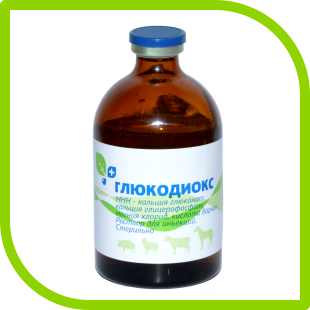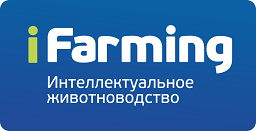
INSTRUCTIONS
of using “Glucodiox” for the treatment of farm animals in tetany, paresis, poisoning, toxicosis, calcium, phosphorus and magnesium exchange disorders, increase in growth and weight gain in young animals.
(organization-developer: “BioKhimPharm”, Raduzhny, Vladimir region).
I. General information
1. Trade name of the medicinal product: Glucodyox.
2. International non-proprietary name: calcium gluconate, calcium glycerophosphate, magnesium chloride, boric acid.
3. Dosage form: solution for injection.
4. Glucodiox as the active substances contains calcium gluconate, calcium glycerophosphate, magnesium chloride, boric acid and solvent – water for injection.
5. The drug is produced in the form of a sterile solution, packaged in 100 ml, 200 ml and 400 ml in hermetically sealed bottles of dark glass, sealed with rubber stoppers, reinforced aluminum caps.
6. The shelf life of the medicinal product under the conditions of storage – 3 years from the date of manufacture, after the first opening of the bottle – no more than 28 days. It is forbidden to use Glucodiox after the expiration date. Store the preparation in the manufacturer’s closed packaging in a dry, protected from direct sunlight place, separate from food and feed, at a temperature of 5 ° C to 25 ° C. Keep the medicine in a place inaccessible to children. Unused product with expired shelf life is disposed of in accordance with legal requirements.
II. Pharmacological properties
7. Glucodiox refers to a group of products containing calcium, phosphorus, magnesium and boron.
The effect of the drug is determined by the effect of the constituent components.
Calcium is involved in the formation of bone tissue (prevents the risk of rickets and osteodystrophy), blood clotting, in the regulation of nerve conduction and muscle contraction, in maintaining stable cardiac activity. It has a restorative, antitoxic effect.
Phosphorus is a constituent element of bone tissue, nucleoproteins and phospholipids. He takes part in all the processes of assimilation in the animal’s body, positively affects the metabolism in the tissues of the body.
Magnesium participates in the metabolism of phosphorus and carbohydrates as a coenzyme. When parenteral administration blocks neuromuscular transmission and prevents the development of seizures.
Boron improves the skeletal system and bone tissue structure, promotes the maintenance and stimulation of the protein synthesis process and promotes the correct exchange of nucleic acids.
Boron participates in the work of the central nervous system, promotes an increase in the level of estrogen and testosterone, which, in turn, has a favorable effect on the growth of muscle mass, improves the metabolism of carbohydrates and fats in the body, participates in all occurring enzymatic processes, enhances insulin’s ability to lower the sugar level in blood.
Boron is necessary for the normal exchange of phosphorus and fluorine, calcium, magnesium. It is also of great importance for the conversion of vitamin D.
Active ingredients Glucodiox are in physiological ratio,
well and quickly absorbed by parenteral administration.
According to the degree of exposure to the body, Glucodioxs according to GOST 12.1.007-76 refers to substances that are not very dangerous (hazard class 4).
III. The order of application
8. Glucodioks are used in a complex of measures for the purpose of treatment and prevention of diseases of farm animals with:
(during pregnancy, lactation, during transportation, grazing and
etc.);
paresis, caused by a lack of calcium and phosphorus; metabolic disorders of calcium, phosphorus, magnesium (rickets, osteodystrophy, osteomalacia, etc.);
poisoning with lead, fluorine, oxalic acid (as an additional remedy for complex treatment);
toxicoses, allergies (urticaria, serum sickness, etc.)
to increase growth and weight gain in young animals of farm animals.
9. Glucodiox is contraindicated in hypercalcemia, acidosis, severe renal dysfunction, atrial fibrillation, increased sensitivity to the components of the drug. It is not recommended to prescribe simultaneously with digitalis preparations, vitamin D and its analogues.
|
Type of animals |
Dose in ml per animal |
Method of administration |
|
Horses weighing up to 500 |
80-100 |
Intravenously |
|
Cattle weighing up to 500 kg (all ages) |
80-100 |
Intravenous, intramuscular, subcutaneous |
|
Sheep, goats (of all ages) |
15-25 |
Intravenous, intramuscular, subcutaneous |
|
Pigs |
15-25 |
Intravenous, intramuscular |
|
Piglets |
2-3 |
Intravenous |
10. Glucodioxs is administered to animals intravenously, intramuscularly or subcutaneously in the following doses:
Glucodioxs is administered once. Repeated use of the drug after 24 hours in the same doses is allowed.
For the prevention of metabolic disorders of calcium, phosphorus and magnesium during pregnancy, lactation, as well as rickets of young farm animals
Glucodiox is used once in the recommended doses.
Glucodioxs is injected subcutaneously in the same place with not more than 50 ml of the drug, intramuscularly – no more than 25 ml. Pigs, sheep and goats intramuscularly in the same place – no more than 15 ml of the drug. Intravenously, the drug is administered slowly and evenly.
Symptoms of an overdose in animals have not been identified.
11. Features of the drug during its first use is not established.
The use of Glucodiox does not exclude the use of other drugs.
Side effects and complications in animals with the use of the drug in accordance with this instruction is not observed, there are no contraindications.
Glucodioxs is not recommended for animals to be administered simultaneously with digitalis, vitamin D and its analogues.
Products of animal origin after application of Glucodiox are used on general grounds.
IV. Personal prevention measures
12. When working with Glucodioxs, you must follow the general rules of personal hygiene and safety, provided for working with medicines.
13. No special precautions should be taken when using Glucodiox. Contact with skin or mucous membranes Glucodiox does not cause an allergic reaction and toxic effects.





